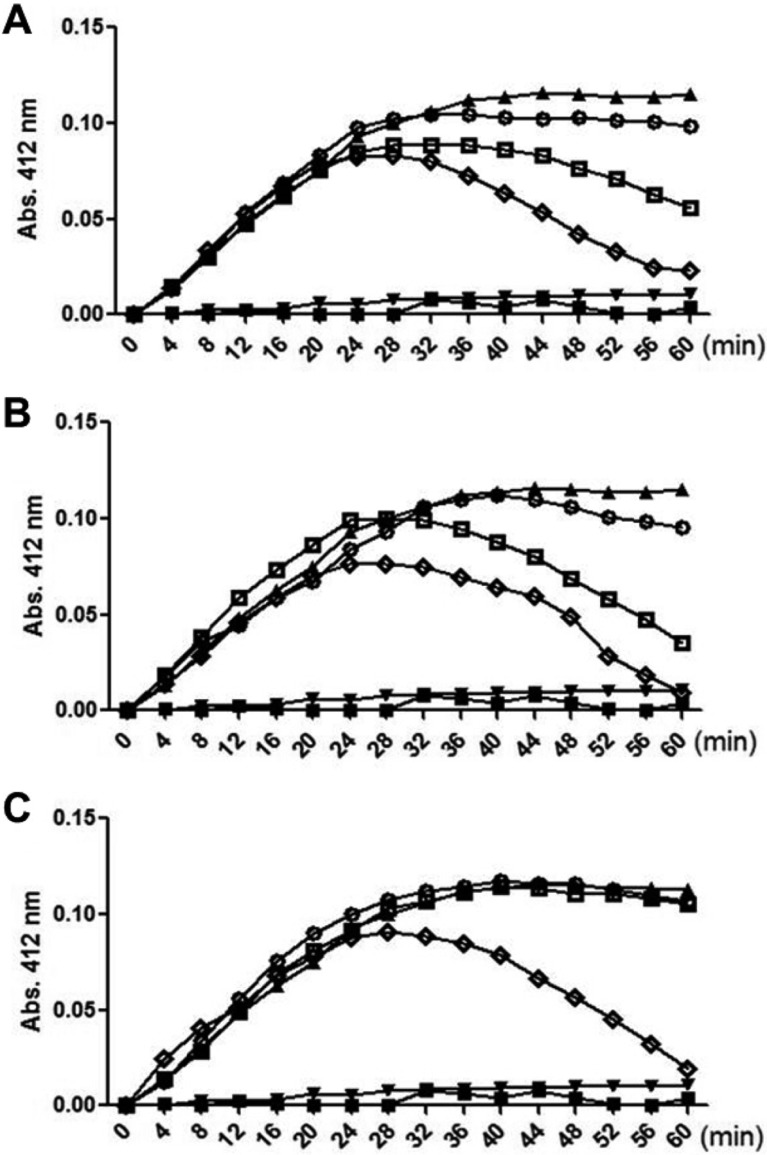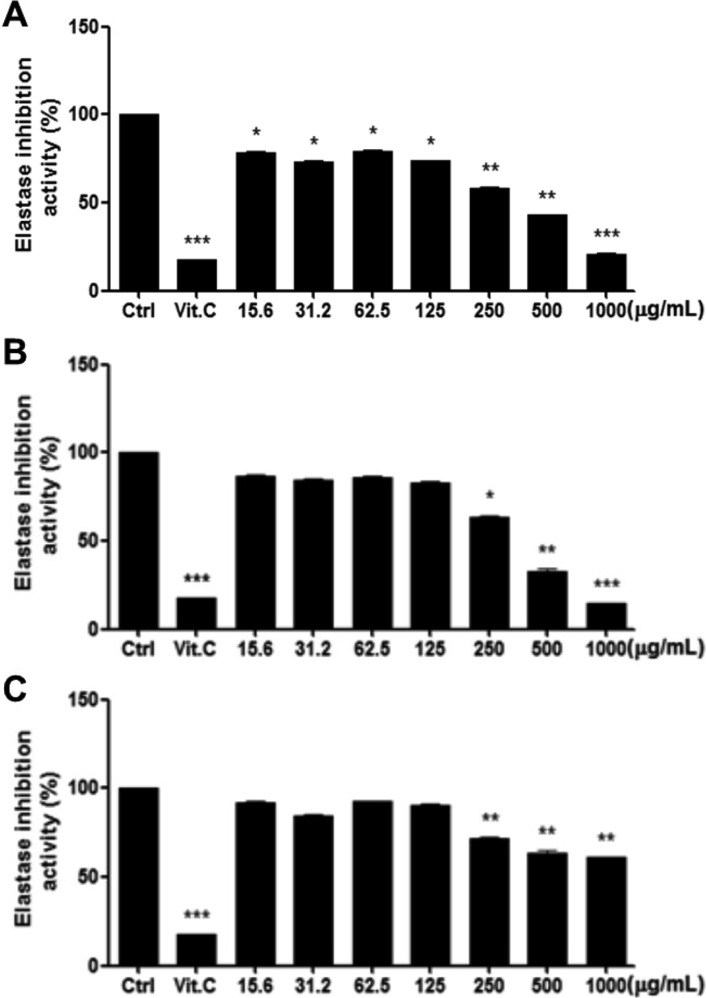Lab Anim Res.
2015 Sep;31(3):148-152. 10.5625/lar.2015.31.3.148.
Extraction conditions of white rose petals for the inhibition of enzymes related to skin aging
- Affiliations
-
- 1College of Veterinary Medicine, Chungbuk National University, Cheongju, Korea. solar93@cbu.ac.kr
- 2Central Research Institute, Dr. Chung's Food Co. Ltd., Cheongju, Korea.
- 3Department of Marine Molecular Biotechnology, Gangneung-Wonju National University, Gangneung, Korea. ssj66@gwnu.ac.kr
- KMID: 2312132
- DOI: http://doi.org/10.5625/lar.2015.31.3.148
Abstract
- In order to assess inhibitory potentials of white rose petal extracts (WRPE) on the activities of enzymes related to dermal aging according to the extraction conditions, three extraction methods were adopted. WRPE was prepared by extracting dried white rose (Rosa hybrida) petals with 50% ethanol (WRPE-EtOH), Pectinex(R) SMASH XXL enzyme (WRPE-enzyme) or high temperature-high pressure (WRPE-HTHP). In the inhibition of matrix metalloproteinase-1, although the enzyme activity was fully inhibited by all 3 extracts at 100 microg/mL in 60 min, partial inhibition (50-70%) was achieved only by WRPE-EtOH and WRPE-enzyme at 50 microg/mL. High concentrations (> or =250 microg/mL) of all 3 extracts markedly inhibited the elastase activity. However, at low concentrations (15.6-125 microg/mL), only WRPE-EtOH inhibited the enzyme activity. Notably, WRPE-EtOH was superior to WRPE-enzyme and WRPE-HTHP in the inhibition of tyrosinase. WRPE-EtOH significantly inhibited the enzyme activity from 31.2 microM, reaching 80% inhibition at 125 microM. In addition to its strong antioxidative activity, the ethanol extract of white rose petals was confirmed to be effective in inhibiting skin aging-related enzymes. Therefore, it is suggested that WRPE-EtOH could be a good candidate for the improvement of skin aging such as wrinkle formation and pigmentation.
MeSH Terms
Figure
Reference
-
1. Lee HB, Lee HB, Lee CY, Kim EK. Trend of depigmenting research based on patent analysis. J Soc Cosmet Sci Korea. 2007; 33(4):209–217.2. Karim AA, Azlan A, Ismail A, Hashim P, Abd Gani SS, Zainudin BH, Abdullah NA. Phenolic composition, antioxidant, anti-wrinkles and tyrosinase inhibitory activities of cocoa pod extract. BMC Complement Altern Med. 2014; 14:381. PMID: 25292439.
Article3. Scharffetter-Kochanek K, Brenneisen P, Wenk J, Herrmann G, Ma W, Kuhr L, Meewes C, Wlaschek M. Photoaging of the skin from phenotype to mechanisms. Exp Gerontol. 2000; 35(3):307–316. PMID: 10832052.4. Gilchrest BA, Park HY, Eller MS, Yaar M. Mechanisms of ultraviolet light-induced pigmentation. Photochem Photobiol. 1996; 63(1):1–10. PMID: 8577860.
Article5. Imokawa G, Nakajima H2, Ishida K3. Biological mechanisms underlying the ultraviolet radiation-induced formation of skin wrinkling and sagging II: over-expression of neprilysin plays an essential role. Int J Mol Sci. 2015; 16(4):7776–7795. PMID: 25856676.6. Alaluf S, Heath A, Carter N, Atkins D, Mahalingam H, Barrett K, Kolb R, Smit N. Variation in melanin content and composition in type V and VI photoexposed and photoprotected human skin: the dominant role of DHI. Pigment Cell Res. 2001; 14(5):337–347. PMID: 11601655.
Article7. Yamaguchi Y, Hearing VJ. Physiological factors that regulate skin pigmentation. Biofactors. 2009; 35(2):193–199. PMID: 19449448.
Article8. Masaki H. Role of antioxidants in the skin: anti-aging effects. J Dermatol Sci. 2010; 58(2):85–90. PMID: 20399614.
Article9. Ohloff G, Demole E. Importance of the odoriferous principle of Bulgarian rose oil in flavour and fragrance chemistry. J Chromatogr. 1987; 406:181–183.
Article10. Kwon SC, Shin S, Jeon JH, Park D, Jang MJ, Kim JJ, Kim CH, Jeong JH, Kim YB. Anti-allergic effects of rose petal extract and Ganoderma luciderm culture on mast cell-mediated allergy model. Lab Anim Res. 2008; 24(1):93–97.11. Jeon JH, Kwon SC, Park D, Shin S, Jang MJ, Joo SS, Kang H, Kim SH, Oh JY, Jeong JH, Kim YB. Effects of red and white rose petal extracts and Ganoderma luciderm culture on ovalbumin-induced atopic dermatitis. Lab Anim Res. 2008; 24(3):347–354.12. Jeon JH, Kwon SC, Park D, Shin S, Jeong JH, Park SY, Hwang SY, Kim YB, Joo SS. Anti-allergic effects of white rose petal extract and anti-atopic properties of its hexane fraction. Arch Pharm Res. 2009; 32(6):823–830. PMID: 19557358.
Article13. Park D, Jeon JH, Kwon SC, Shin S, Jang JY, Jeong HS, Lee DI, Kim YB, Joo SS. Antioxidative activities of white rose flower extract and pharmaceutical advantages of its hexane fraction via free radical scavenging effects. Biochem Cell Biol. 2009; 87(6):943–952. PMID: 19935880.
Article14. Joo SS, Kim YB, Lee DI. Antimicrobial and antioxidant properties of secondary metabolites from white rose flower. Plant Pathol J. 2010; 26(1):57–62.
Article15. Yang G, Park D, Lee SH, Bae DK, Yang YH, Kyung J, Kim D, Choi EK, Hong JT, Jeong HS, Kim HJ, Jang SK, Joo SS, Kim YB. Neuroprotective Effects of a Butanol Fraction of Rosa hybrida Petals in a Middle Cerebral Artery Occlusion Model. Biomol Ther (Seoul). 2013; 21(6):454–461. PMID: 24404336.
Article16. Olech M, Nowak R, Nowacka N, Pecio L, Oleszek W, Los R, Malm A, Rzymowska J. Evaluation of rose roots, a post-harvest plantation residues as a source of phytochemicals with radical scavenging, cytotoxic, and antimicrobial activity. Ind Crop Prod. 2015; 69:129–136.17. Zhang W, Abdel-Rahman FH, Saleh MA. Natural resistance of rose petals to microbial attack. J Environ Sci Health B. 2011; 46(5):381–393. PMID: 21614712.
Article18. Lee HJ, Kim HS, Kim ST, Park D, Hong JT, Kim YB, Joo SS. Anti-inflammatory effects of hexane fraction from white rose flower extracts via inhibition of inflammatory repertoires. Biomol Ther. 2011; 19(3):331–335.
Article19. Oh H, Siano B, Diamond S. Neutrophil isolation protocol. J Vis Exp. 2008; (17):745. PMID: 19066523.
Article20. Kondo S. The roles of cytokines in photoaging. J Dermatol Sci. 2000; 23(Suppl 1):S30–S36. PMID: 10764989.
Article21. Vincenti MP, Brinckerhoff CE. Transcriptional regulation of collagenase (MMP-1, MMP-13) genes in arthritis: integration of complex signaling pathways for the recruitment of gene-specific transcription factors. Arthritis Res. 2002; 4(3):157–164. PMID: 12010565.
Article22. Ryu BM, Qian ZJ, Kim MM, Nam KW, Kim SK. Anti-photoaging activity and inhibition of matrix metalloproteinase (MMP) by marine red alga, Corallina pilulifera methanol extract. Radiat Phys Chem Oxf Engl 1993. 2009; 78(2):98–105.23. Yamaguchi Y, Hearing VJ. Physiological factors that regulate skin pigmentation. Biofactors. 2009; 35(2):193–199.
Article24. Hunt G, Todd C, Cresswell JE, Thody AJ. Alpha-melanocyte stimulating hormone and its analogue Nle4DPhe7 alpha-MSH affect morphology, tyrosinase activity and melanogenesis in cultured human melanocytes. J Cell Sci. 1994; 107(Pt 1):205–211. PMID: 8175909.
Article25. Yoon JH, Shim JS, Cho Y, Baek NI, Lee CW, Kim HS, Hwang JK. Depigmentation of melanocytes by isopanduratin A and 4-hydroxypanduratin A isolated from Kaempferia pandurata ROXB. Biol Pharm Bull. 2007; 30(11):2141–2145. PMID: 17978489.26. Kim YB, Joo SS. Cosmetic composition comprising white rose flower extract for skin whitening and improving skin wrinkle. Korean patent submission No. 10-2013-0065333.27. Choi JK, Lee YB, Lee KH, Im HC, Kim YB, Choi EK, Joo SS, Jang SK, Han NS, Kim CH. Extraction conditions for phenolic compounds with antioxidant activities from white rose petals. J Appl Biol Chem. 2015; 58(2):117–124.
Article
- Full Text Links
- Actions
-
Cited
- CITED
-
- Close
- Share
- Similar articles
-
- Inhibition of Cytochrome P450 Enzymes by Drugs—Molecular Basis and Practical Applications
- The Effects of Extracts from Green Tea, Guajava Leaves and Rose Petals on Allergic Rhinitis: A Randomized Double Blind Study
- A Case of White Fibrous Papulosis of the Neck
- The Effects of Extracts from Green Tea, Guajava Leaves and Rose Petals on Allergic Rhinitis: A Randomized Double Blind Control Study
- Skin Aging




